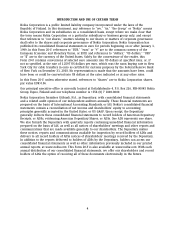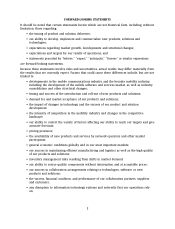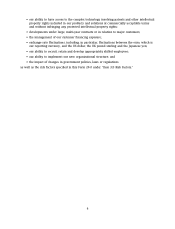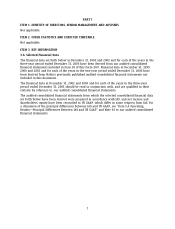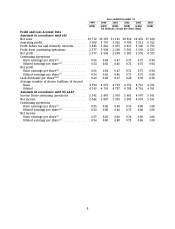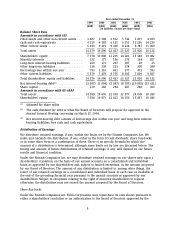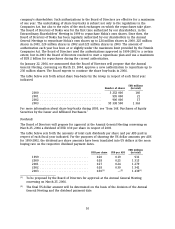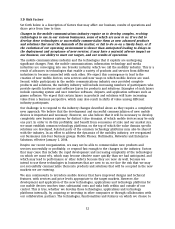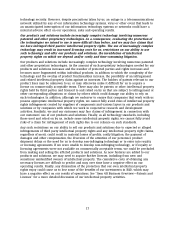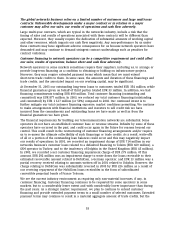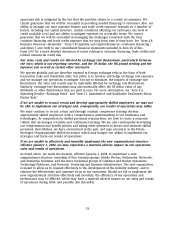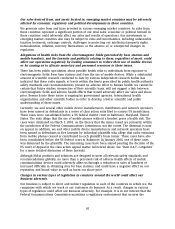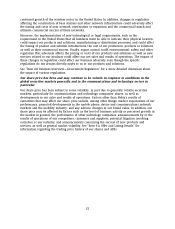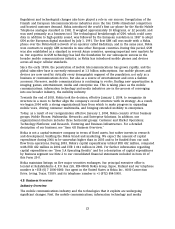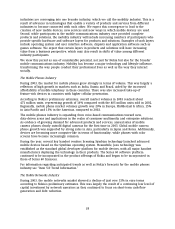Nokia 2003 Annual Report Download - page 15
Download and view the complete annual report
Please find page 15 of the 2003 Nokia annual report below. You can navigate through the pages in the report by either clicking on the pages listed below, or by using the keyword search tool below to find specific information within the annual report.price, operational and manufacturing efficiency, technical performance, product features, quality,
customer support, and brand recognition. Mobile network operators are increasingly offering
mobile devices under their own brand, which may result in increasing competition from
non-branded mobile device manufacturers. Finally, a number of factors, including actual or even
alleged defaults in our products and solutions, may have a negative effect on our reputation and
erode the value of the Nokia brand, which we regard as one of our key competitive advantages.
The industry trends described in the previous risk factor mean that the mobile communications
industry’s competitive landscape is changing in ways that present us with new risks. First, as the
mobile communications, information technology and media industries are converging into one
broader industry, each industry participant must now compete against a wider sphere of
competitors than before, many of whom may be relatively new to each other and many of whom
may have substantial competitive strengths in their core industries. For example, our principal
competitors have historically been other mobile communications companies such as Ericsson,
Motorola, Nortel, Samsung and Siemens. Now, in addition, we must compete in our multimedia
business with consumer electronics manufacturers and in our enterprise solutions business with
business device and solution providers. Second, as the mobility industry will include increasing
numbers of participants who provide specific hardware and software layers within products and
solutions, we must also be competitive at the level of these layers rather than solely at the level of
products and solutions. As a result of these developments, we face new competitors such as, but
not limited to, Cisco, Dell, HP, Microsoft, Nintendo and Sony, and we must also compete with a
great number of smaller competitors and with some of our traditional competitors in new areas.
Finally, the development of new technologies and potential changes in customer behavior may
also change the competitive landscape for our products and solutions in ways that we cannot
currently predict. Moreover, in the businesses that we are entering that are new to us or are at
the early stages of their development, such as those targeted by the Multimedia and Enterprise
Solutions business groups, the competitive environment may develop differently from our
expectations. As a result, we may not be able to predict and adapt successfully to the future
competition facing our various business segments, and we may find that we have not optimally
positioned ourselves to compete in the future.
Reaching our targets depends on numerous factors, such as our ability to offer products and
solutions that meet the demands of the market and to manage the prices and costs of our
products and solutions, our operational efficiency, the pace of development and acceptance of
new technologies, our entry into new business areas, and general economic conditions.
Depending on those factors, some of which we may influence and others of which are
beyond our control, we may fail to reach our targets and we may fail to provide accurate
forecasts of our sales and results of operations.
A variety of factors could affect our ability to reach our targets and give accurate forecasts.
Although, we can influence some of these factors, some of them depend on external factors that
are beyond our control.
In our mobile device businesses, we seek to maintain healthy levels of sales and profitability
through offering a competitive portfolio of mobile devices, growing faster than the market,
working to improve our operational efficiency, controlling our costs, and targeting timely and
successful product introductions and shipments. For us a competitive portfolio means a wide and
balanced mix of commercially appealing mobile devices with attractive features, functionality and
design, covering all major user segments and price points. The quarterly and annual sales and
operating results in our mobile device businesses also depend on a number of other factors that
are not within our control. Such factors include the global growth rate in mobile device volumes,
which is influenced by regional economic factors in our major markets; competitive pressures;
14


